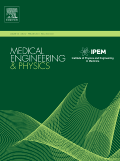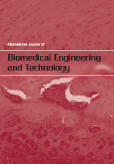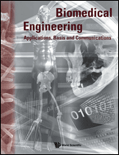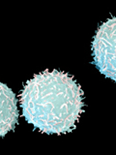
MEDICAL ENGINEERING & PHYSICS
Scope & Guideline
Advancing the Frontiers of Medical Technology
Introduction
Aims and Scopes
- Biomedical Engineering Applications:
Research that explores the application of engineering principles and design concepts to medicine and biology, including the development of medical devices, imaging technologies, and therapeutic methods. - Biomechanics and Rehabilitation Engineering:
Studies focused on understanding the mechanics of human movement and the development of assistive technologies, prosthetics, and rehabilitation devices to improve patient outcomes. - Medical Imaging and Signal Processing:
Innovative methods in imaging technologies, including MRI, CT, and ultrasound, alongside advanced signal processing techniques for accurate diagnosis and monitoring. - Machine Learning and AI in Healthcare:
Utilization of artificial intelligence and machine learning techniques for predictive modeling, diagnostics, and personalized medicine, showcasing their integration into clinical workflows. - Tissue Engineering and Biomaterials:
Research on the development of new materials and scaffolds for tissue engineering applications, focusing on biocompatibility and mechanical properties for medical implants.
Trending and Emerging
- Robotics in Surgery:
An increasing number of studies are dedicated to the development and application of robotic systems in surgical procedures, emphasizing improved precision, reduced invasiveness, and enhanced recovery times. - Wearable Technology and Remote Monitoring:
Research on wearable devices and sensors for health monitoring is on the rise, focusing on real-time data collection and analysis for chronic disease management and rehabilitation. - Advanced Imaging Techniques:
Emerging methodologies in imaging, such as hybrid imaging and AI-enhanced analysis, are becoming more prevalent, enabling more accurate diagnostics and treatment planning. - 3D Printing in Healthcare:
The application of 3D printing technologies for custom medical devices, prosthetics, and tissue engineering is gaining momentum, showcasing the potential for personalized medicine. - Telemedicine and Digital Health Solutions:
The shift towards telemedicine and digital health applications is reflected in recent studies focusing on remote diagnostics, virtual consultations, and mobile health technologies.
Declining or Waning
- Traditional Surgical Techniques:
There has been a noticeable decline in research focusing solely on conventional surgical methods, as the field shifts towards robotic-assisted and minimally invasive techniques that offer enhanced precision and recovery. - Basic Biomechanical Studies:
While foundational biomechanics research remains important, the journal has seen fewer publications centered on basic biomechanical principles without direct clinical applications, as there is a stronger emphasis on interdisciplinary approaches. - Conventional Imaging Techniques:
The focus has shifted away from traditional imaging methods that do not incorporate advanced computational techniques or machine learning, as newer technologies provide more insightful and efficient diagnostics. - Generalized Rehabilitation Approaches:
Research that does not incorporate personalized or technology-driven rehabilitation methods is becoming less prominent, as tailored interventions and smart rehabilitation technologies gain traction. - Static Modeling in Biomechanics:
There is a waning interest in purely static models of biomechanical systems, with a growing preference for dynamic simulations and real-time analysis that capture the complexities of human movement.
Similar Journals

PROCEEDINGS OF THE INSTITUTION OF MECHANICAL ENGINEERS PART H-JOURNAL OF ENGINEERING IN MEDICINE
Transforming Medicine: Engineering the Future of HealthcareProceedings of the Institution of Mechanical Engineers Part H - Journal of Engineering in Medicine is a pivotal publication in the interdisciplinary realm of mechanical engineering and medical technology. Published by SAGE Publications Ltd, this esteemed journal delivers cutting-edge research and innovative solutions that bridge the gap between engineering principles and medical applications. With an impressive reputation, the journal is ranked in the Q2 category for Mechanical Engineering and Q3 for miscellaneous Medicine in 2023, reflecting its significant contribution to the field. Boasting an impact factor that positions it favorably in both mechanical engineering and medical research, it serves as a critical platform for researchers, professionals, and students eager to advance their knowledge and influence the future of engineering in healthcare. This journal encompasses diverse topics, driving forward the synergy between engineering and medicine while promoting discussions and discoveries that shape industry practices globally.

International Journal of Biomedical Engineering and Technology
Driving Progress in Biomedical Engineering and TechnologyThe International Journal of Biomedical Engineering and Technology, published by INDERSCIENCE ENTERPRISES LTD, serves as a pivotal platform for the dissemination of innovative research in the field of biomedical engineering. This journal, with ISSN 1752-6418 and E-ISSN 1752-6426, has been a valuable resource since its inception in 2007, boasting a converged publication timeline extending to 2024. Based in the United Kingdom, the journal aims to bridge the gap between engineering and biomedical sciences, facilitating interdisciplinary collaboration. As reflected in its 2023 Scopus ranking in the Q4 quartile of Biomedical Engineering, the journal remains accessible for researchers at various stages of their careers, contributing to its significance in promoting advancements in healthcare technologies. While currently not an open-access publication, the journal remains dedicated to enriching the biomedical engineering community by presenting novel research that addresses critical challenges, ultimately aiming to improve patient outcomes and drive innovation in medical devices and therapies.

Journal of Medical Signals & Sensors
Empowering Healthcare Through Open Access KnowledgeJournal of Medical Signals & Sensors, published by Wolters Kluwer Medknow Publications, is a pioneering platform in the fields of Biomedical Engineering, Computer Science, and Health Informatics, focusing on innovative research and advancements in medical technology. With an Open Access policy since 2012, the journal promotes widespread dissemination of knowledge, aiming to facilitate the sharing of vital insights and developments among researchers, healthcare professionals, and students globally. The journal has achieved commendable rankings in its various categories, including Q3 in Biomedical Engineering and Radiology, underscoring its importance in advancing health technology and informatics. Its commitment to rigorous peer review ensures that published works are of the highest quality, making it a valuable resource for those engaged in cutting-edge medical research. With annual publications planned through 2024, the Journal of Medical Signals & Sensors continues to expand its influence and relevance in a rapidly evolving scientific landscape.

BIOMEDICAL ENGINEERING-APPLICATIONS BASIS COMMUNICATIONS
Innovating solutions for tomorrow's biomedical challenges.BIOMEDICAL ENGINEERING-APPLICATIONS BASIS COMMUNICATIONS is a prominent journal dedicated to the dynamic field of biomedical engineering, published by WORLD SCIENTIFIC PUBL CO PTE LTD. Since its inception in 1992, the journal has provided a platform for the dissemination of high-quality research and innovative applications within the biomedical engineering domain. Despite its current Q4 ranking in multiple categories such as Bioengineering and Biomedical Engineering, the journal serves as an essential resource for researchers and professionals seeking to explore the latest developments and practical applications in this interdisciplinary field. The journal is based in Singapore, reflecting the region's growing influence in scientific research and technology. Although it does not offer open access, it continues to attract submissions that enrich the scientific dialogue within its community. With a commitment to fostering knowledge and research collaboration, this journal remains a vital contributor to the ongoing advancements in biomedical technology and engineering.

Bioengineering & Translational Medicine
Advancing Biomedical Discoveries for Better HealthBioengineering & Translational Medicine, published by WILEY, positions itself at the forefront of innovation in the fields of biomedical engineering, biotechnology, and pharmaceutical science. With an impressive impact factor reflected through its top-tier Q1 rankings in multiple categories, the journal serves as a critical platform for disseminating cutting-edge research and stimulating discourse among professionals and scholars since its establishment as an open-access journal in 2016. Key to its mission is facilitating the translation of bioengineering research into tangible medical applications, thereby enhancing healthcare outcomes. With its comprehensive scope, it attracts a diverse readership, including researchers, industry leaders, and students eager to engage with the latest developments in translational medicine. The journal operates under robust access options, ensuring that research is freely available for maximum reach and impact, fostering collaboration and innovation across disciplines worldwide.

Annual Review of Biomedical Engineering
Transforming Ideas into Innovations in Biomedical EngineeringAnnual Review of Biomedical Engineering, published by Annual Reviews, stands as a leading academic journal dedicated to the rapidly evolving field of biomedical engineering. With an impressive impact factor that reflects its high citation rates and rigorous peer-review process, this journal offers critical insights by synthesizing cutting-edge advancements and applications in both biomedical engineering and miscellaneous medicine. The journal, which is available in both print (ISSN: 1523-9829) and electronic formats (E-ISSN: 1545-4274), serves as an essential resource for researchers, professionals, and students aiming to stay abreast of significant developments and emerging trends. As of 2023, it is recognized in the top tier (Q1) for both Biomedical Engineering and Medicine, showcasing its esteemed position within the academic community, reflected in its high Scopus rankings. Spanning from 1999 to 2024, the Annual Review of Biomedical Engineering continues to catalyze interdisciplinary collaboration and innovation at the intersection of engineering and healthcare.

BME Frontiers
Bridging Research and Real-World Healthcare SolutionsBME Frontiers, published by the American Association for the Advancement of Science, is an innovative open-access journal dedicated to the burgeoning field of Biomedical Engineering. Since its establishment in 2020, this journal has aimed to bridge the gap between cutting-edge research and practical application, promoting advancements in biomedical technologies, medical devices, and healthcare solutions. Boasting impressive rankings within Scopus—64th among 398 in Medicine (miscellaneous) and 81st among 303 in Biomedical Engineering—BME Frontiers stands out as a significant contributor to scholarly communication, offering rich insights for researchers, professionals, and students alike. With consistent publication projected through 2024, the journal serves as an essential platform for disseminating high-quality research that can drive innovation and inspire new approaches in the healthcare sector.

Biomedical Engineering Online
Unlocking the future of healthcare through open-access knowledge.Biomedical Engineering Online, published by BMC, is an esteemed open-access journal in the United Kingdom that has been advancing the field of biomedical engineering since its inception in 2002. With a commitment to disseminating high-quality research, the journal encompasses a broad scope, including innovative studies in biomaterials, imaging technologies, and medical applications. Recognized within the Q2 quartile for various categories such as Biomaterials and Biomedical Engineering, it ranks favorably among its peers: Rank #58 out of 333 in Radiology, and Rank #15 out of 63 in Radiological and Ultrasound Technology in the Scopus database. These rankings, coupled with an open-access model, ensure that critical advancements in medical technology are accessible to researchers, health professionals, and students globally. As it continues through its converged years from 2002 to 2024, Biomedical Engineering Online remains an invaluable resource for anyone involved in the cutting-edge intersection of engineering and medicine.

ANNALS OF BIOMEDICAL ENGINEERING
Pioneering research for a healthier tomorrow.ANNALS OF BIOMEDICAL ENGINEERING is a premier journal in the field of biomedical engineering, published by Springer. Established in 1972, this journal has become a vital resource for researchers, professionals, and students engaged in the rapidly evolving domain of biomedical technology. With a commendable impact factor and ranked in the 76th percentile among its peers as per Scopus, it exemplifies excellence in disseminating critical research findings. The journal covers a broad scope of topics related to the integration of engineering principles with medical and biological sciences, facilitating innovations that enhance healthcare outcomes. Although open access is not offered in this journal, it remains an essential platform for scholarly communication, contributing to the continuous advancement of knowledge in biomedical engineering. ANNALS OF BIOMEDICAL ENGINEERING is not only a bridge for academics to share groundbreaking research but also an influential guide for practical applications in medicine and health technologies, making it a fundamental publication for its readership.

Sovremennye Tehnologii v Medicine
Exploring the Future of Medicine Through InnovationSovremennye Tehnologii v Medicine is a prominent academic journal dedicated to the exploration and dissemination of contemporary technologies in the field of medicine. Published by the esteemed Nizhniy Novgorod State Medical Academy, this journal serves as a vital platform for researchers, healthcare professionals, and students seeking to stay at the forefront of advancements in biochemistry, genetics, and molecular biology. With an impact factor that positions it within the Q3 quartile for both Biochemistry, Genetics and Molecular Biology and Medicine categories as of 2023, it highlights a commitment to quality research. The journal, identified by the ISSN 2076-4243, provides a rich repository of knowledge for those interested in the innovative applications of medical science, contributing significantly to the academic discourse and the practical world of healthcare. With an open access option, it ensures that its valuable content is readily accessible to a global audience, fostering collaborative advancements in modern medical practices.